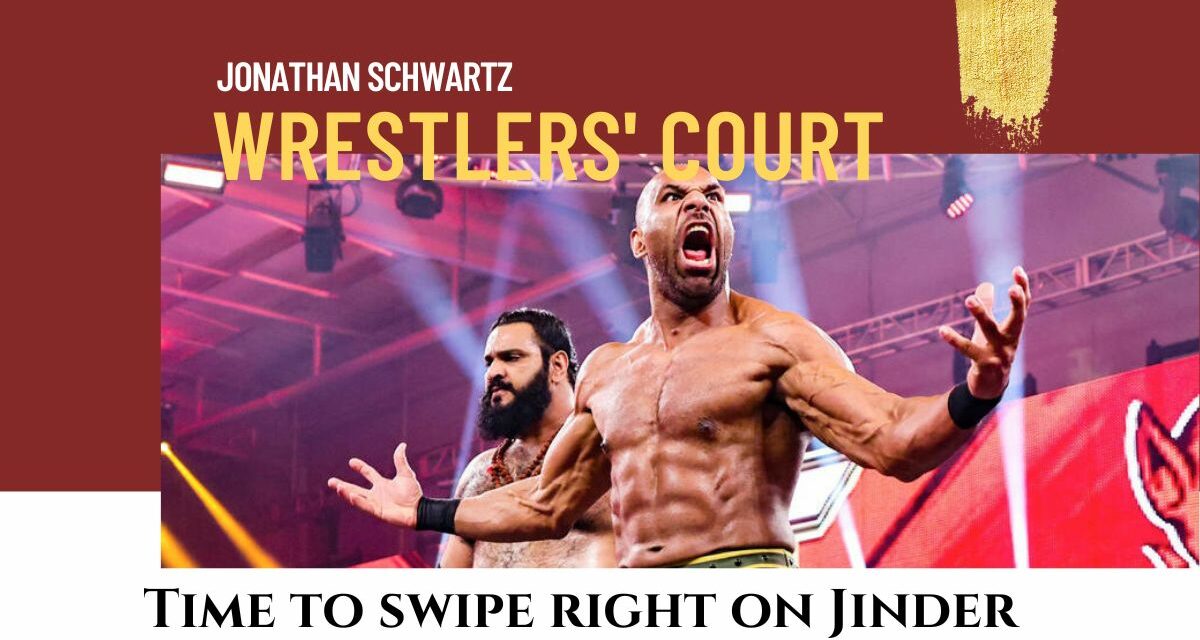On January 1, 2014, WWE hosted a special ‘Day 1’ edition of Monday Night Raw.
From my vantagepoint, the show was pretty much like any other with the exception of rumblings that a former WWE champion would be putting in an appearance. While the internet’s heart went a flutter, I was a bit more sanguine. After all, I’d just written about the fact that sooner or later every WWE talent whose name doesn’t rhyme with Blunderfaker leaves, and almost all of them come back.
If you’ve been watching WWE for any length of time you know how these appearances go. Regardless of how the ex-champ was booked out the door, if they were a significant presence during their original run (like Steve Austin, Goldberg, Batista or Edge), they are greeted with a hero’s welcome.
Their pops are often facilitated by an expendable mid-card heel riling up the crowd. In recent years, this job would often fall to the likes of Nic ‘Dolph Ziggler’ Nemeth, who added credibility to his eventual beatdown given his own status as a momentary world champion. Mr. Ziggler (or his proxy) was doomed to receive his comeuppance at the hands of the hero, no matter how clearly said hero was embroiled in a Three Way Dance against the evil mid-carder and the throes of middle age.
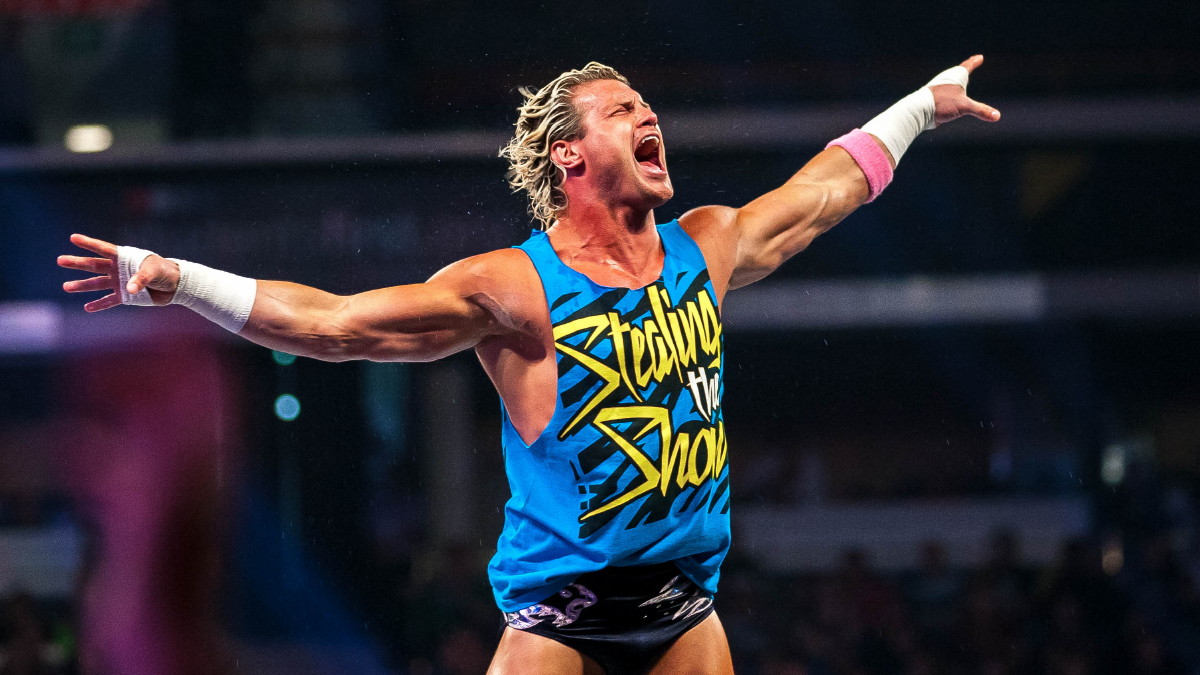
Nic ‘Dolph Ziggler’ Nemeth
The formula is throttled to reflect the alumnus’ strength on the microphone by using a more or less bloviating heel to set up a catch phrase or two, and to cover off the returnee’s physical limitations. This is probably why Ziggler was used so often. Dolph could hold his own in a verbal battle against just about anyone (he did study pre-law as a shoot) and excels at the physical part of pro wrestling — flopping around to sell offence as well as anyone since prime ‘Mr. Perfect’ Curt Hennig or Shawn Michaels. I understand that age and overexposure eventually sent Mr. Ziggler packing. He’s recently resurfaced under his given name in New Japan Pro Wrestling and the recently-re-re-branded Total Nonstop Action Wrestling, where I hope he gets one last chance to show what he can do. I’d also welcome a more solid title run or two before he heads off to the more dangerous world of full-time stand up comedy.
But I digress. Back to the formula.
A versatile antagonist helps sweeten the pop for a returning champ and if need be, provides a test to determine whether the appearance turns into a one-and-done, a brief run up to a meaningful pay-per-view program, or perhaps a more sustained second (or third, or fourth) act. I’ll offer two hypothetical examples: A returning Rob Van Dam isn’t the best promo guy but he can still work a credible match as evidenced by his recent AEW appearances (although those might pose as a bar to WWE using him any time soon). Mick Foley can still render a speech that is by turns heartbreaking and terrifying with its promise of violence, but in ring he’s best served to shoving his favorite gym sock down his opponents’ throats, even better if he applies it in the corner of the ring so he doesn’t have to tax his clearly ailing knees and back.
The pattern works best when the returning champion:
- Was demonstrably popular during his reign: Historically championships changed hands so rarely that even a transitional champion received a measure of respect. Day 1’s repeated Iron Sheik shoutouts are a good example even if I wasn’t a fan of how they turned out. In recent years, the roster has been filled with lesser titlists who meander down the cards until they’re mostly enhancement talent like Ziggler (who in fairness could still pop up and snag a title when the urge struck the bookers as Bron Breakker well knows), Jake ‘Jack Swagger’ Hager, the Miz, Kofi Kingston, Jeff Hardy or Big E (the latter only because so far his career appears to have been cut short due to injury) or perhaps more controversially champions like Big Show, Mark Henry, Rey Mysterio or Chris Jericho who enjoyed a few stronger runs but spent most of their careers outside the main event.
- Left with their reputation intact: Over the years WWF/WWE hasn’t been shy about extracting as much perceived value as possible from their talent before showing them the door. This is a longstanding pro wrestling tradition. Going back to the territory days a departing talent would be expected to ‘do the honors’ and lose to incoming wrestlers as a means of forwarding the promotion’s storylines. Ric Flair dropped the WWF title to Bret Hart at a Saskatchewan house show shortly before he left the company. Hart was immediately established as a champion to watch. Flair in losing still looked great and resurfaced in WCW ready to reclaim the championship that many thought he’d never lost. Less appealing, Pedro Morales held the WWWF title for over 1,000 days from 1971-1973. He was also the WW(W)F’s first Triple Crown winner, collecting the Intercontinental and Tag Team championships along the way. By the time I started watching wrestling in the mid-1980s he was regularly featured on WWF syndicated programming, losing each week to the heel of the moment. While WWE has come around to celebrating parts of its history, including prodigal champions like Bruno Sammartino, Bret Hart and Hulk Hogan, Morales remains relatively obscure apart from the occasional vignette during National Hispanic Heritage Month. For someone whose championship run was only recently eclipsed by Roman Reigns (and the last checkpoint before Bob Backlund and Hogan), Morales deserved more.
- Has maintained a degree of notoriety outside of pro wrestling during his time away from WWE: Either working for other promotions, building a presence in Hollywood by acting or hosting morning shows, participating in more legitimate sports or less legitimate ventures like politics.
- Has been gone long enough to be missed by current fans, but not so long that his fan base has largely been overtaken by younger siblings or worse, children: By that point, the return becomes a pure nostalgia pop and with a few exceptions, any in ring action is so unbelievable that it hurts the returnee’s legacy and the current heel’s prospects.
I acknowledge that my distinction between ‘greater’ and ‘lesser’ champions is entirely subjective and occasionally contradictory. I’m also missing a whole bunch of more and less worthy names. I think you could make cases on either side of the ledger for champions who enjoyed single reigns or a series of short runs with few great matches.
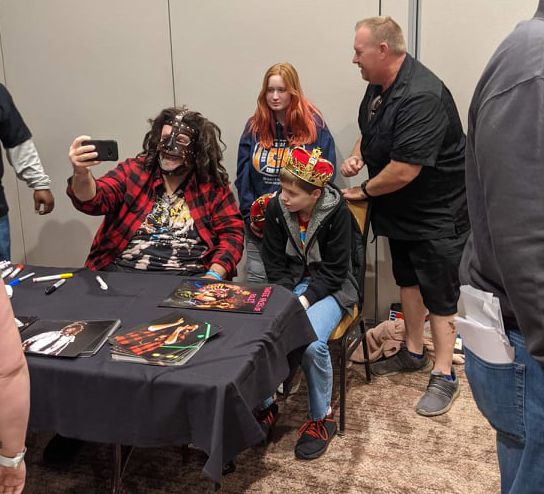
Mick Foley as Mankind at WrestleCade, November 26-28, 2021, at the Benton Convention Center in Winston-Salem, NC. Photo by Greg Mosorjak
Objectively, Foley’s three WWF title reigns were exceedingly brief. Subjectively, the story leading into and out of those reigns was superb and helped make him a legend. Charitably, he held the WWF championship for a little over a month in total. Bray Wyatt clocked in 49 days as WWE champion (he had other runs with the Universal title). Sgt Slaughter made it just over the two month mark. Rob Van Dam didn’t even last a month. Kane, Rey Mysterio and Andre the Giant lasted a day at most, but I think each of these champions made a bigger impact on the WWF/WWE’s world title scene than say, John ‘Bradshaw’ Layfield, Sheamus or Bobby Lashley. There’s a lot more to the caliber of a champion than the number of days or title defenses.
I’m a fan of most of the wrestlers I write about. I take nothing away from their accomplishments. Even understanding that title belts are props first, winning a world championship means that the promotion places trust in that wrestler’s ability to carry the title for however long, and counts on the champion to perform in and out of the ring to help build the promotion’s brand. It’s a role I’ll never play. And for the purposes of welcoming back a wrestler who’s positioned as a legend, these ‘beta’ titlists can do a great job of putting the featured talent over.
Which brings me to January 1, and all that has followed.
At this point it’s no surprise that Raw’s surprise guest was Dwayne ‘The Rock’ Johnson. His appearance drew over 171 million views on social media, breaking the previous record for a WWE-related event set mere weeks ago by CM Punk’s return at Survivor Series (The Rock seems to have cornered the market on upstaging Punk. Hopefully, as Paul ‘Triple H’ Levesque might say, Punk has experienced enough ‘personal growth’ that this doesn’t bother him). The key takeaway from the Rock’s comeback was a barely veiled threat that he plans to wrest the ‘head of the table’ and the WWE Universal Championship from Roman Reigns.
And the Rock’s coming back… to SAAAN DIIIIIEEEEEEEEEEGOOOOOOOOO followed the template that I set out earlier, although instead of the Impact Zone bound Ziggler, the role of heel party pooper was played by Jinder Mahal.
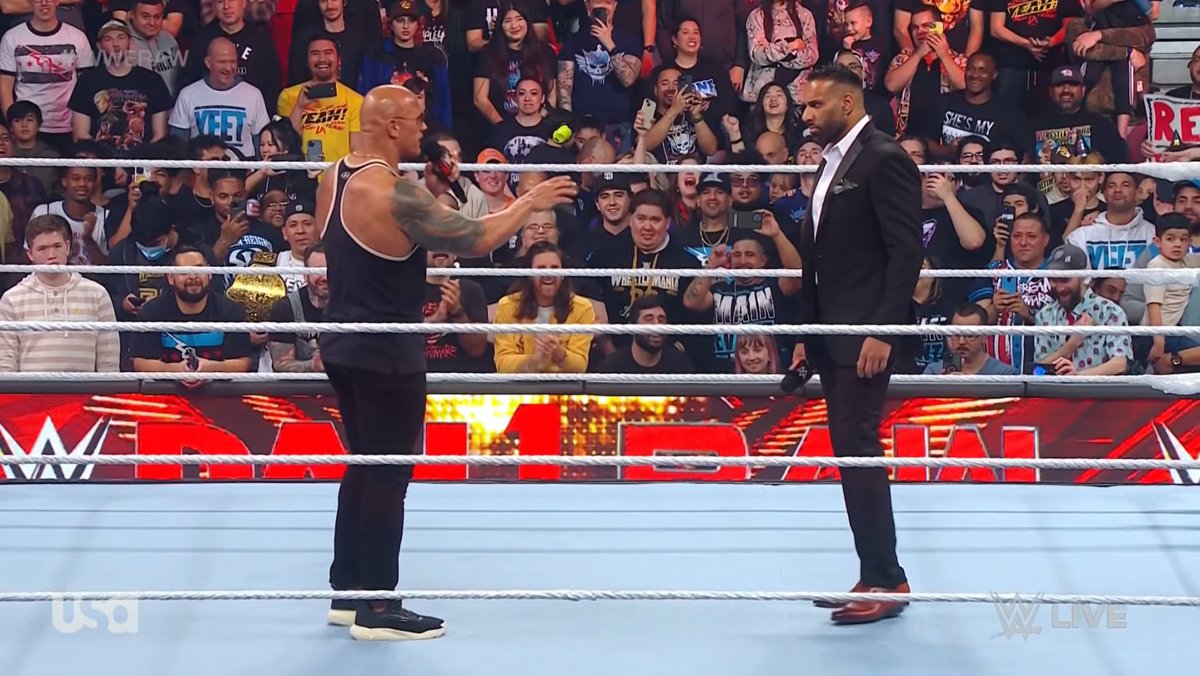
A face-off between The Rock (left) and Jinder Mahal. Photo: WWE
In case you missed it (and if you did, may I suggest Joseph Casciaro’s excellent recap on this very website) The Rock’s return took place about two thirds of the way into the show, following a bait and switch by Mahal. He came out to his usual regal entrance music and TitanTron (which I have to say, next to Miz’s is one of the best entrance packages going) and wasted no time riling up the crowd. He established his presence by declaring himself a former and future WWE champion (true, at least the first part and hopefully the second) then pivoted to his disappointment in the United States of America. Mahal called out the division within the US (also true, if you follow the news) and claimed that the US is a former superpower turned joke.
Interestingly, Mahal namechecked the Iron Sheik in full kayfabe mode. He praised the villainous America-hating character from the 1980s which has long since been overtaken in the public consciousness by the Magen-managed member of Howard Stern’s Wack Pack (a bit more on this later).
Mahal’s promo was well delivered but standard stuff for a foreign heel, even one who represents a country that lacks an antagonistic relationship with America (mind you, that didn’t stop Vince McMahon from turning Bulgaria into a belligerent foe). Mahal somehow argued that he would unify the country without offering specifics. So did Trump, and he didn’t even offer his tax records. Look how well that went.
Mahal then allegedly recited “The Star-Spangled Banner” in Punjabi and castigated the crowd for booing it. Returning to the language for a further tirade, he was finally interrupted by The Rock’s music, a prophecy made whole.
The Rock emerged to the crowd going bananas, fueled by their desire to hinder Jinder (it seems like every internet writer is contractually obligated to use this rhyme, though I wonder why we don’t ask what pains Roman Reigns or who’s being mean to John Cena). As Mr. Casciaro writes:
[Rock] told Mahal he was in trouble tonight and belittled Mahal for comparing himself to The Iron Sheik. Mahal said of course The People’s Champion is back and Rock should be ashamed to represent these people. However, Rock said he is damn proud to represent them, proud to be an American and proud to say “The Rock has finally come back to San Diego!”
Witty banter ensued.
The Rock specifically called out the Iron Sheik reference, launching into an impression that makes Hank Azaria’s accent as Apu seem politically correct (foreshadowing).
It hit an odd note, I didn’t get the callouts to the Iron Sheik throughout the segment. I loved to hate Sheik, but he was Iranian. It felt like whoever wrote the segment didn’t care about such things. Tying the two heels together felt lazy, as if to say that both men were foreigners from across an ocean and were marketed to look and sound exotic; wrestling retreating to tired Orientalism to cultivate hatred. Even more so given the disjunct between Mahal’s treatment of Sheik in character as a legitimate threat and fellow World Champion, versus The Rock’s retreat to the substance addled walking meme he became in a post-kayfabe world. While The Rock made clear his love for the man who turned his cousin Rikishi into the Sultan, his treatment of the Iron Sheik felt disrespectful compared to Mahal’s. I felt like this exchange almost turned Jinder babyface.
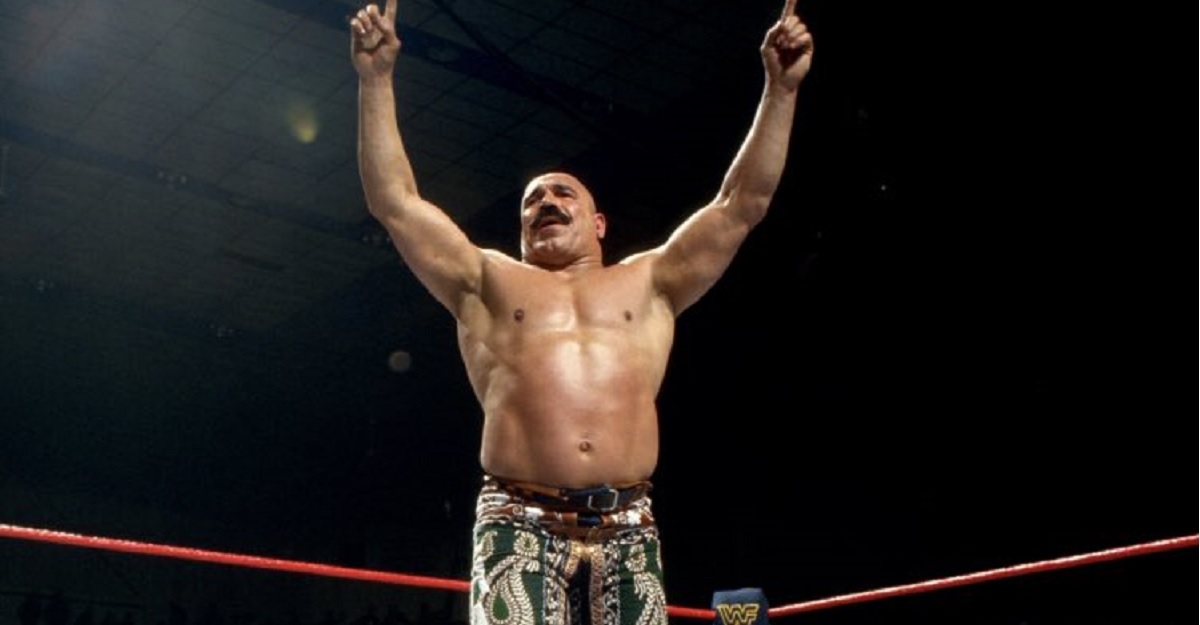
Hossein Khosrow Ali Vaziri, The Iron Sheik
I’ll leave aside the fact that as far as the whole Patriotic American vs. Foreign Menace thing goes, The Rock vs. Jinder Mahal rings a little hollow.
Johnson was born in Hayward, California, but lived most of his life on the run like many children of pro wrestlers. In case this is the first SlamWrestling.net article you’ve read, The Rock’s father, Rocky Johnson was Canadian (and quite the rolling stone). His mother, Ata was either born in Hawaii before it became a State or in Samoa, adopted into the Maivia-Anoa’I family when her mother Lia married High Chief Peter Maivia (like many families, it seems like The Rock’s is a mix of fact and fiction, so maybe read this part lightly). In any case, casting The Rock as an old school patriot feels just a bit off, it’s not a facet of his character on which he’s relied. Even the rhymes with Thundermaker played the patriot more explicitly in his career. And he’s dead.
As far as the WWE Universe knows, Mahal is from India. He has consistently played up his heritage, even wearing a turban as part of the leather pants-clad rock band 3MB. His entrances have featured Bollywood imagery, Bollywood dancers and the Bollywood Boyz. He inflects his promos with an accent like any good ethnic heel and, as was the case on January 1, he can berate the audience in a foreign language, in this case at least to my untrained ears I think it’s Punjabi. I’m skeptical. I remember Nikita Koloff barking in an accent that sounds more like Klingon than Russian. More recently Sacha Baron Cohen played Borat, who’s version of ‘Khazakh’ was actually Hebrew with a bunch of loanwords tossed in and a vaguely Slavic accent.
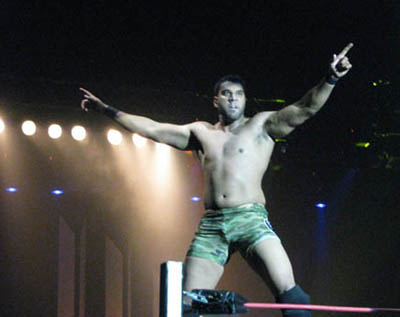
When he was Tiger Rah Singh. SlamWrestling.net file photo
Mahal actually hails from Calgary. According to Wikipedia he holds a business degree from the University of Calgary and has been vocal in his support of the left-leaning New Democrat Party and its leader Jagmeet Singh in our last federal election. He is also part of a prominent Stampede Wrestling family. His uncle worked for decades as the heel ‘The Great’ Gama Singh and he was trained for the ring by Singh, ‘Champagne’ Gerry Morrow and the late, great ‘Bad News’ Allen Coage. If you’re familiar with Bad News and love his work like I do, watch Mahal when he goes into his patented Villainous Scowl. It reads as a tribute to one of the best mean-muggers in the history of the business and was rightfully called out by The Rock during their promo battle, punctuated by some self-deprecating Baywatch jokes and The Rock’s new schtick, which involves coming up with a blue nickname for the heel then encouraging the audience to sing along.
Of course, this gentlemen’s exchange devolved into violence. Mahal got his predictable comeuppance in the form of a half-lifted spinebuster and Winded People’s Elbow. The Rock retrieved the microphone and teased adding an epilogue to his story by challenging Roman Reigns
As these segments go, it worked admirably, although as mentioned I think the faux patriotism took a bit away from the story. As a former, arguably lesser and almost forgotten world champion seeking a return to the spotlight Mahal had enough reason to seize the ring without bashing America. The Rock could still have vanquished Mahal and moved on to challenge Reigns without wrapping himself in the flag, which feels dated and weirdly controversial given current socio-political trends.
I suggest that Mahal’s performance opened a few eyes among WWE executives. The following week he would come back to RAW and issue a challenge to Seth Rollins for the WWE World Heavyweight Championship. Mahal acquitted himself admirably in this promo battle, too. Even better since he focused less on the anti- American stuff and more on the unfairness of his ignored title run and his desire to return to championship glory.
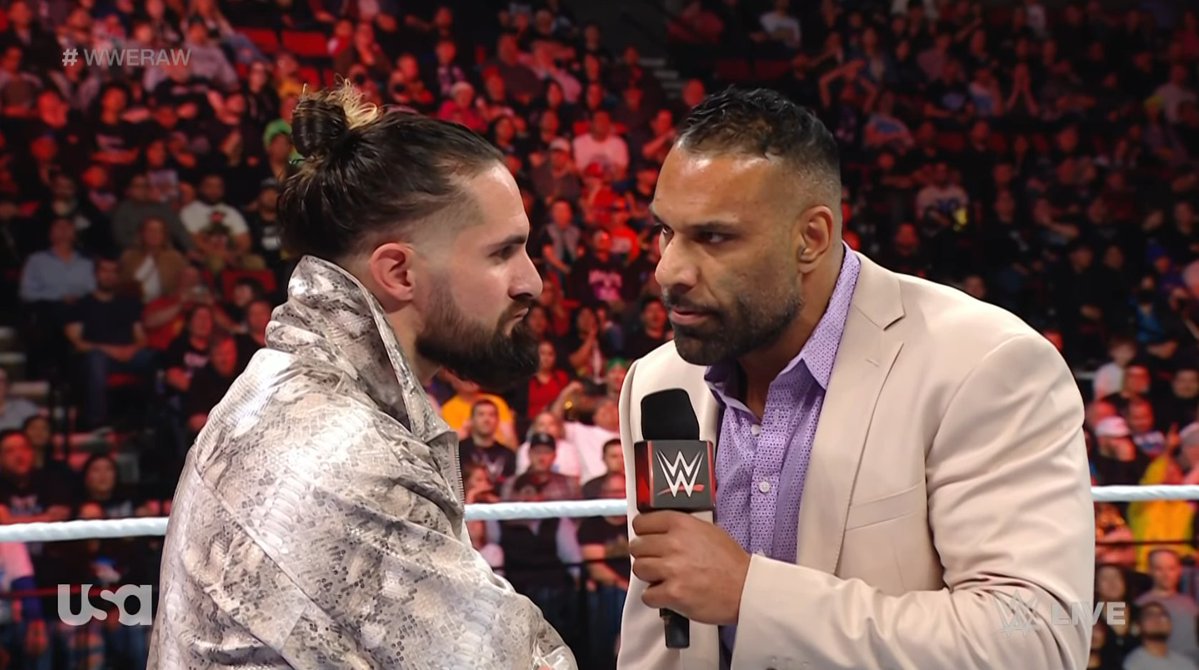
Jinder Mahal (right) wants the world title from Seth Rollins. WWE Photo
Rollins agreed to a title shot which took place this past Monday on Raw. The current champ eked out a victory in a very good if short match that made Mahal look like a main event star while advancing storylines with Rollins, Drew McIntyre and Damien Priest heading into the Royal Rumble. Word is that Rollins may have legitimately injured himself during the match, so we’ll see what happens there. If a new champion is required, I wouldn’t be bothered if an audible were called placing Mahal in the contest to succeed Rollins, with him winning as the presumptive favorites are busy attacking each other. But that’s putting the cart before the horse.
I don’t know if WWE has room for this much nuance but Mahal has come out of the past few weeks as a slightly more sympathetic heel. This is a good thing since the key to any compelling villain is their belief that they hold the moral high ground. It’s what makes Drew McIntyre’s recent shift in attitude interesting as well. McIntyre is frustrated that his own (much longer) title run is diminished by the fact that it took place during the COVID pandemic, away from arenas full of cheering fans worldwide. He is bothered that his attempts to regain a world championship have been stymied by factions and outside interference. He is mortified that some of those responsible (like Jey Uso) are now cheered themselves. Add in McIntyre’s disdain for a series of leapfrogging challengers who were elsewhere while he took WWE on his shoulders when the world stopped (like Cody Rhodes and CM Punk) and McIntyre can reasonably position himself as the only sane man in a world gone mad. He’s becoming a heel, but to a certain segment of the audience (myself included) he’s the good guy because his complaints have merit.
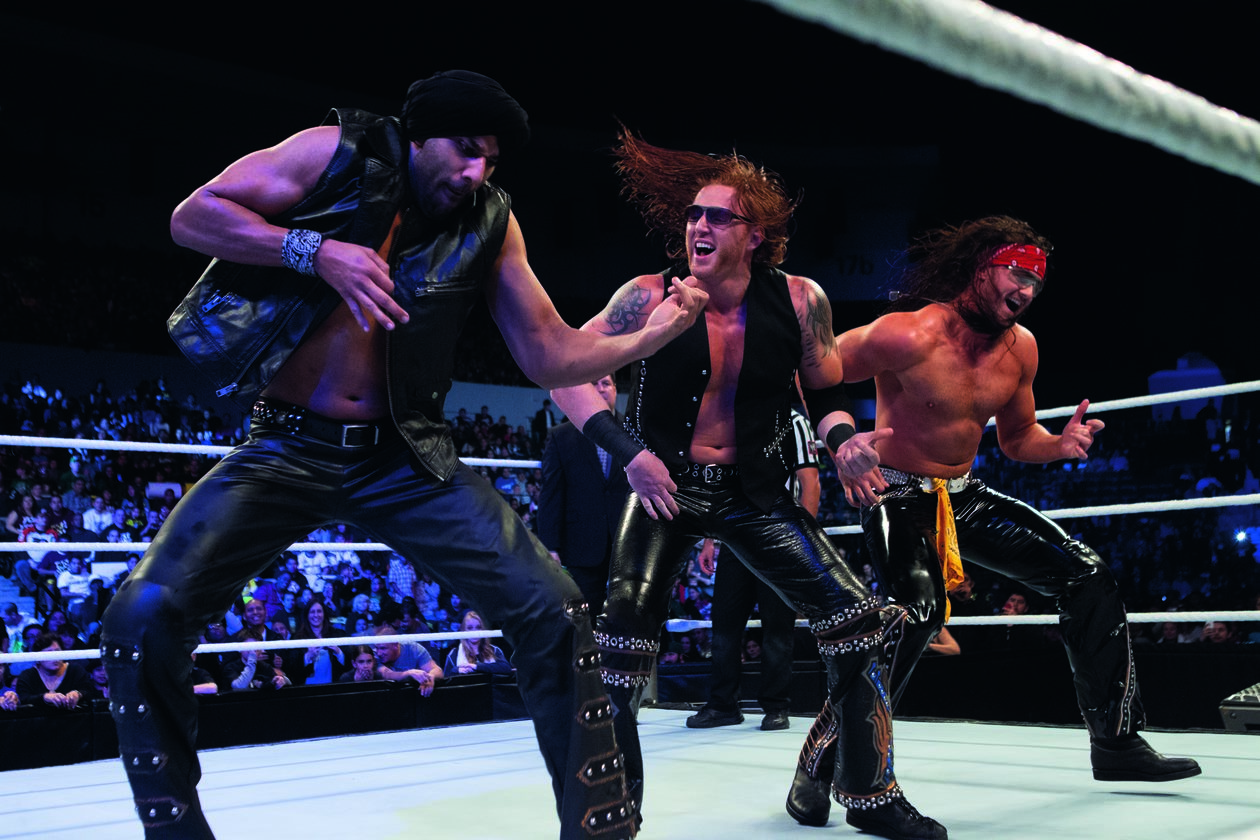
WWE’s resident “rock band,” 3MB (Jinder Mahal, Heath Slater and Drew McIntyre), playing a mean air guitar on Saturday Morning Slam, February 2, 2013. WWE photo
A loose alliance between two big, bad, self-righteous former champions in Mahal and McIntyre could be fun in a late 1990s heel Bret Hart kind of way. Hart built one of the better latter-day stables in his reconstituted Hart Foundation. If Heath Slater can be found and has done similar work on himself as did McIntyre and Mahal, a returning, serious 3MB faction might be awesome. Give Slater an NXT title run and one could even argue that after the Shield, they’re the second stable in which all three men held a World Title.
Leading in to Mahal’s match against Rollins, WWE announcers and social media played up his title run — particularly the fact that he beat Randy Orton decisively for the belt. Backstage this reign was likely calculated as part of a strategy to help open up WWE to the Southeast Asian market, but I still liked it. Mahal’s swift ascension to contention brought someone new into a title picture that had long been dominated by the same few faces. I enjoyed it the same way I appreciated JBL’s shocking reign when he beat Eddie Guerrero, who himself had dethroned Brock Lesnar against all odds. There’s something to be said for a career mid-carder getting a chance to run with the title and making the most of it. Mahal and McIntyre both deserve at least one more run before they’re through.
Not bad for a performer who has been relegated mostly to managerial duties and who hasn’t won a singles match in over a year.
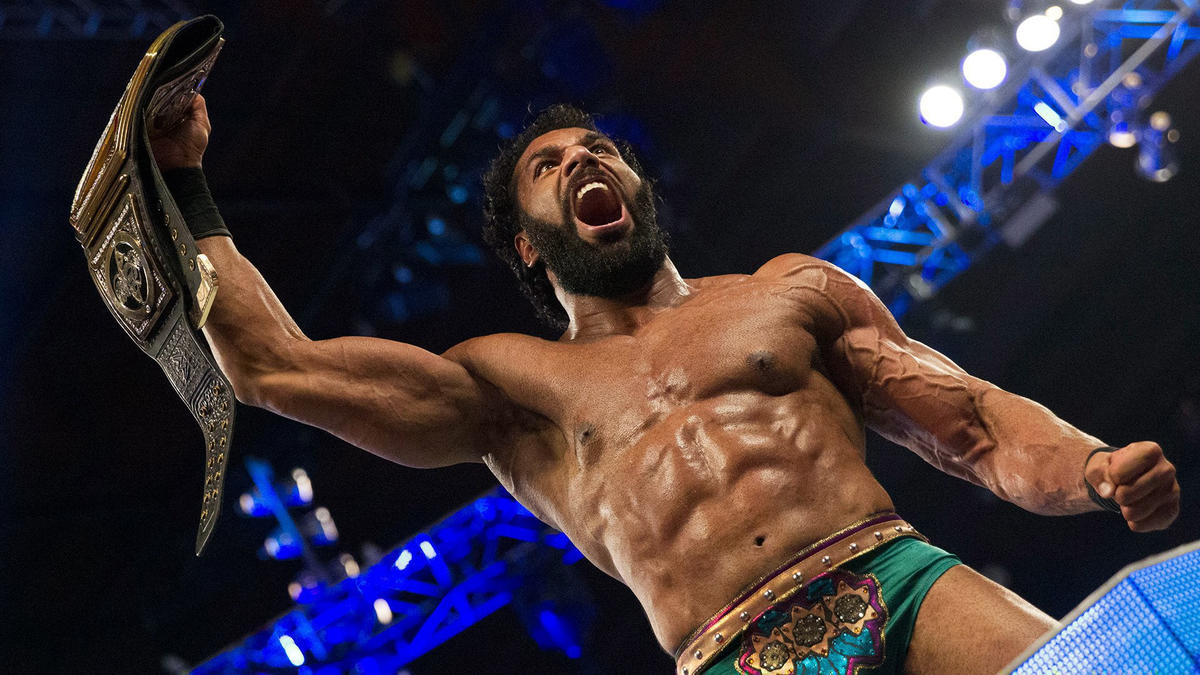
Jinder Mahal winning the WWE championship. Photo:WWE
The latter fact has added a neat, only-in-pro-wrestling wrinkle to Mahal’s story. I suspect that while WWE follows social media closely it still prefers its own plans to the internet commentariat. But when the CEO of a rival organization takes to ex-Twitter to bash the booking that led to Mahal’s title shot one should take notice.
No sooner was this match announced than AEW owner Tony Khan posted his disbelief that fans would prefer a winless Jinder Mahal getting a title shot to his own plans of matching current FTW champ HOOK against Samoa Joe for AEW’s World championship. Fans were quick to defend WWE against Khan’s wrath. They also spoke up directly in favor of Jinder, perhaps realizing just how good he was in the face of unwarranted criticism.
Pro wrestling outcomes are still scripted and good interviews and matches warrant further exposure even if they seem hastily booked. For years WWE was criticized for refusing to push talent that grabbed the audience’s attention or slowing pushes to the point of lost interest. Fans were also quick to point out instances where Khan booked brand new talent into title matches with next to no AEW experience. Adam Copeland got his first shot at Christian Cage’s TNT title with one match under his belt, While HOOK may have won several bouts in 2023, most of those contests were card filler. HOOK is a strangely compelling performer, especially since he barely talks, but trying to sell him as a threat to Samoa Joe given their obvious physical mismatch (two inches in height and 80 pounds in weight) is no more believable than Mahal beating Rollins. At least Mahal has championship precedent on his side. Raw’s broadcast home, the USA Network, got in on the action. So did Eric Bischoff. The Rock put Mahal over on his social media. Jonathan Coachman went meta on Khan, laughing at his incredulity over titles which have always been props. As Coachman put it, he could have been world champion if the storyline called for it. No professional professional wrestler would get worked up over what is basically a MccGuffin. For raising Mahal’s profile as he did, it wouldn’t surprise me if, whenever Mahal’s WWE run ends, Khan seeks to sign him to AEW.
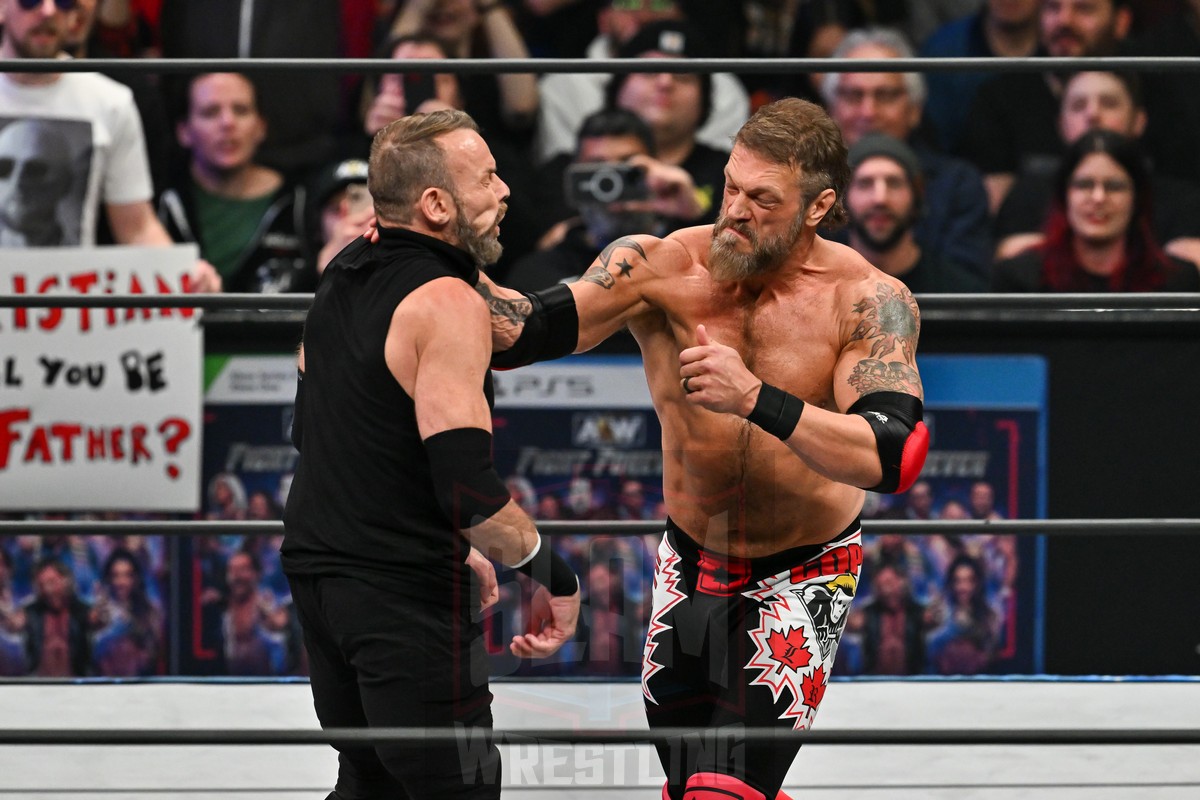
AEW TNT Championship: Christian Cage (c) Vs. Adam Copeland at AEW Dynamite at Centre Bell in Montreal, Quebec, on Wednesday, December 6, 2023. Photo by Minas Panagiotakis, www.photography514.com
For his part, Mahal may have posted one of the best wrestling comebacks outside Hogan’s ‘Hulking up,’ Chief Jay Strongbow’s ‘war dance’ or Bobo Brazil’s shuffle. In a since deleted Tweet, Mahal asked “Who TF is Hook?” Even a late run-in by HOOK’s dad Taz couldn’t mitigate the shade. In my view, this response means Mahal should win the Royal Rumble, beat Roman Reigns and break Bruno Sammartino’s record title run. Or at least travel back up the card as a strong heel for a good long while.
I’m probably a minority (with a pulpit, which is awesome) but I’ve always liked Mahal a lot better than many of the wrestlers who do get pushed. Especially since he came back. He’s big, legitimately the same size as perennial main eventers like Drew McIntyre and Randy Orton. On his return from exile he got and has kept himself in main event shape. He matches up well physically against anyone on the roster. Like most Calgary graduates, he can actually wrestle and is a great conniving heel. Mahal’s promos, which range from disaffected and aloof (as witnessed against The Rock) to full on outrage, are good enough that they keep using him to try to get a series of Indian giants over (The Great Khali, Shanky, Indus Sher). I don’t think he’s ever had the chance to fully let loose on the microphone, but he gets his heel character and its motivations across well.
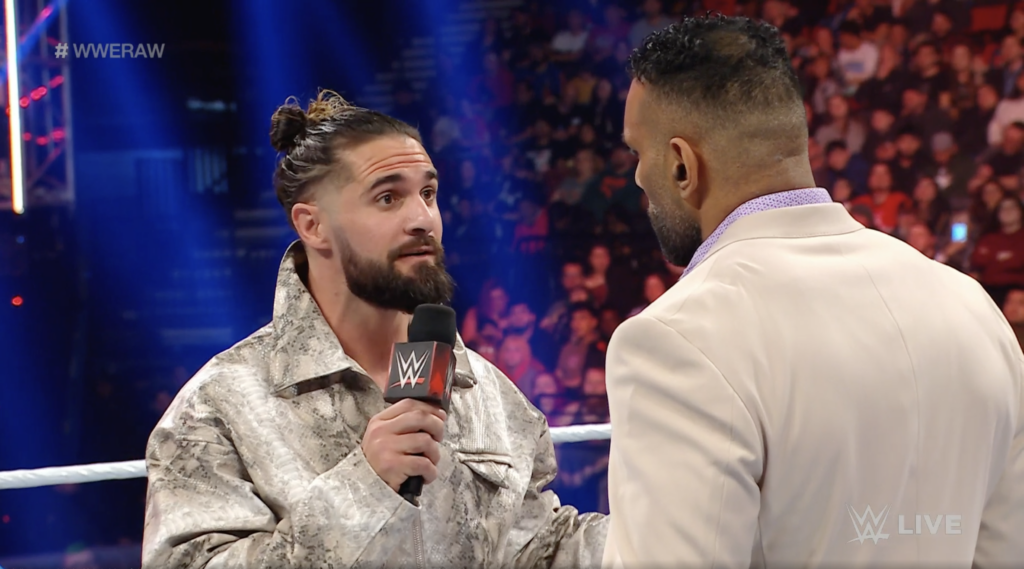
Seth Rollins (left) and Jinder Mahal talking trash to one another. Photo: WWE
Mahal wrestles in an environment where it’s difficult to play a foreign menace, much less one hailing from a country whose portrayal in the media is acknowledged as out of date and offensive. Mahal’s indignation during his promo against the Rock would have been easier to accept coming from a country like Russia or Iran, which were/are openly hostile or even Finland given its lack of pollution.
Popular media portrayals like the nerdy Raj on The Big Bang Theory, Kwik-E-Mart owner Apu on the Simpsons (which was recently the subject of controversy in its own right), a litany of blink-and-you-miss-them cab drivers and doctors and call center workers, or culture shocked suitors across the 90 Day Fiancée universe don’t drive the same audience reactions as Ivan Koloff or the Iron Sheik or Mr. Fuji. Canadian and Japanese fans will remember Tiger Jeet Singh, who worked a Wildman gimmick in the vein of the Original Sheik — swapping out the prayer rug and smudge pot for a sword swung madly into the crowd. Mahal’s promo against The Rock worked, but it was hampered by the fact that Mahal was less the emissary of an evil empire than a disaffected foreigner complaining about his lot in life.
Today WWE gets in trouble with these characters. Twenty plus years ago Muhammad Hassan was initially written as an Arab American who was disenchanted with increased levels of Islamophobia following 9/11. Within months he was pivoted to a terrorist, complete with threatened beheadings. It is not as unthinkable as I wish it would be. Especially with a portion of the world’s population, including Canada and the US (and some prominent wrestlers who won’t be named here again) cheering on the beheaders.
In any case, Mahal may not be the best promo but I’d rate him as equal to McIntyre on that front… and if I’m being honest my favorite wrestler ever, Bret ‘Hitman’ Hart was much better in ring than on the microphone. Given what felt like challenging material before an unprimed audience, Mahal more than held his own against one of the greatest talkers in pro wrestling.
I haven’t seen Mahal work as a babyface other than an abortive attempt at a turn when he was saddled with the useless dancing fool Shanky, but thankfully that experiment ended quickly. Still, I would argue that used correctly, Mahal has the potential to bring a huge underserviced community of wrestling fans with him.
I could see a turn at some point if for no other reason than to optimize a ready fan base. Mahal’s surprising WWE title win was largely seen as part of WWE’s attempt to broaden its presence in India, which boasts the world’s largest population (1.4 billion people) and a rapidly rising middle class. The Indian diaspora includes over one million people in the United Kingdom and and another million in South Africa, almost two million in Canada, and over three million in the United States. This makes Mahal feel less like a foreign menace and more like part of the multicultural-melting pot ideologies that have made Canada and the US thrive.
That said, I wonder whether in WWE’s attempt to win over an international market, they have glossed over local divisions. Mahal is a member of the Sikh community, a broadly respected religious and cultural minority, some members of which have sought independence from India and neighboring Pakistan giving rise to tensions between neighbors. That said, there are approximately 28 million Sikh people in India, about 500,000 in the UK, almost 800,000 in Canada and roughly 500,000 in the US. At the risk of overgeneralizing based on unrelated experience, the Canadian Sikh community (which is concentrated in Vancouver and Toronto, though Calgary and Edmonton have growing populations) like many immigrant communities has a tendency to show up as a bloc to support its members. I would imagine that like most communities the world’s Sikh community values fair representation. They share in their members’ accomplishments and feel concerned when presented with offensive stereotypes the same way that I cheer Bill Goldberg, MJF or Alexa Bliss or for that matter Canadian wrestlers like Bret Hart, Kevin Owens, Jacques Rougeau Jr. (even as the villainous Mountie) and yes, Jinder Mahal. Wrestling embraces identity politics and has since well before Bruno Sammartino ruled New York or the flamboyant Gorgeous George caused near riots in California. Mahal’s appeal to this demographic may be tempered by the fact that he’s still a heel and the Indian wrestling audience has enough access to WWE programming that they might not want to cheer on a ‘bad guy,’ especially one who loses frequently. Whatever their background, everyone loves a winner.
Mahal returned to RAW on Day 1 of 2024 in what could have been a paint by numbers segment designed to launch The Rock back into the bigger WWE picture. With any luck, Mahal will benefit as well and Day 1 will be the first of many brighter days for a deserving featured player.
To paraphrase a certain app, it’s time to swipe right on Jinder.
TOP PHOTO: Jinder Mahal is jacked. WWE Photo
RELATED LINKS
